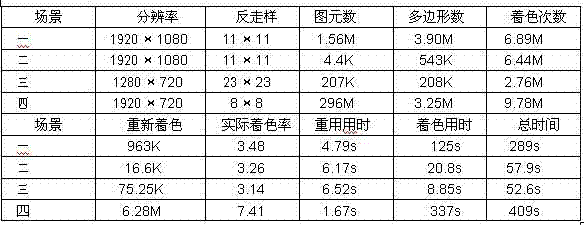Coloring reuse method for micro-polygon ray tracing
A ray tracing and polygon technology, applied in 3D image processing, instrumentation, calculation, etc., can solve the problems of unavailable highlight reflection and ineffective mapping, so as to reduce the amount of shading calculation, improve performance, and ensure accuracy. Effect
- Summary
- Abstract
- Description
- Claims
- Application Information
AI Technical Summary
Problems solved by technology
Method used
Image
Examples
Embodiment 1
[0030] Example one The inventor used the method of the present invention to draw four typical scenes, including a common battle scene in a movie (scene 1), a scene with a magnifying glass with reflection / refraction and a metal object with displacement maps (scene 2), and There are scenes with motion-blurred cars passing through tunnels (Scene 3) and a highly complex scene with waterside castles and woods (Scene 4). Table 1 shows the performance statistics of the method of the present invention in all scenes. Among them, the reuse time is all the extra time reused for coloring, including the time for constructing kd trees, searching for nearest neighbors, and collecting recoloring samples. The actual shading rate is the average number of shading calculations on each pixel actually measured. Due to the layering of the scene and the need to recalculate the shading, this value is generally slightly larger than the shading rate specified by the user. As shown in the table, the meth...
Embodiment 2
[0033] Example two The inventor compared the results of the non-reuse coloring results, the results of this method, and the results of the decoupled sampling method as a reference in the second scenario above. For decoupled sampling methods, please refer to RAGAN-KELLEY, J., LEHTINEN, J., CHEN, J., DOGGETT, M., AND DURAND, F. 2011. Decoupled sampling for graphics pipelines. ACM Trans. Graph. 30, 3 ( May), 17:1–17:17. The result is that the results of this method are visually consistent with the reference results. In the decoupling sampling method, the coloring value will only be reused between samples belonging to the same primitive and these samples have the same hash value under the standard decoupling mapping, where the decoupling mapping calculates the sample by projecting the sample onto the image plane The integer hash value of, defocus is not considered during the projection process. Since this mapping does not consider the magnification and deformation caused by ray...
PUM
 Login to View More
Login to View More Abstract
Description
Claims
Application Information
 Login to View More
Login to View More - Generate Ideas
- Intellectual Property
- Life Sciences
- Materials
- Tech Scout
- Unparalleled Data Quality
- Higher Quality Content
- 60% Fewer Hallucinations
Browse by: Latest US Patents, China's latest patents, Technical Efficacy Thesaurus, Application Domain, Technology Topic, Popular Technical Reports.
© 2025 PatSnap. All rights reserved.Legal|Privacy policy|Modern Slavery Act Transparency Statement|Sitemap|About US| Contact US: help@patsnap.com

